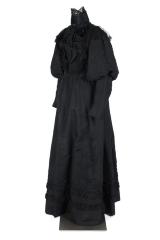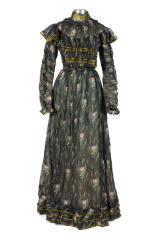This object has been deaccessioned and is no longer in the GRPM's collection
Comments and Tags
Be the first to comment on this item!
Clothing and Accessories
Women's Clothing ➔ Day Dress
Identifier:
199543Description:
This batiste lingerie day dress features a floral lace collar and a net panel on the center front of the bodice. There are lace inserts on the back of the bodice and on the sleeves. The three-quarter length sleeves have a floral lace trim. There is floral embroidery throughout the dress on the bodice and the skirt. Features that indicate this dress is from the early 1900s are the monobosom, the three-quarter length sleeves, and the lace inserts.The lingerie dress was a style of day dress that appeared at the end of the Victorian Era in the late 1890s and remained popular through the Edwardian Era until around 1915. It is typically a white dress made of lightweight cotton such as muslin or batiste that incorporates lace inserts, ruffles, and embroidery. This style of dress was popular among women of both lower and upper classes. Although white clothing used to symbolize wealth, the lingerie dress was worn by women of all social statuses because it was easy to create thanks to sewing machines, readily available patterns, and machine-constructed laces. The color white was used because of its ease to wash and also because this style of dress was created to mimic women’s undergarments, using the same color, fabrics, and decor. It was commonly worn for afternoon functions during warmer weather and was also referred to as a tea dress or a lingerie frock.


